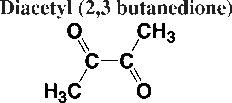Diacetyl: Difference between revisions
Jump to navigation
Jump to search
(Added Diacetyl rest, link to BYO) |
Uncle Jesse (talk | contribs) No edit summary |
||
| Line 1: | Line 1: | ||
[[file:diacetyl.gif|thumb|232px|right|Diacetyl]] | [[file:diacetyl.gif|thumb|232px|right|Diacetyl]] | ||
Diacetyl arises naturally as a byproduct of [[fermentation]]. At low levels, diacetyl contributes a slipperiness to the feel of the alcoholic beverage in the mouth. As levels increase, it imparts a buttery or butterscotch flavor. It is generally considered a fault at too high of a level in [[beer]] or [[ | Diacetyl arises naturally as a byproduct of [[fermentation]]. At low levels, diacetyl contributes a slipperiness to the feel of the alcoholic beverage in the mouth. As levels increase, it imparts a buttery or butterscotch flavor. It is generally considered a fault at too high of a level in [[beer]] or [[distillate]]s. The simplest way to reduce diacetyl is to increase fermentation temperatures near the end - called a Diacetyl Rest. The remaining yeast remove it by storing it in the yeast cell where it cannot be tasted. | ||
Latest revision as of 01:06, 8 October 2017
Diacetyl arises naturally as a byproduct of fermentation. At low levels, diacetyl contributes a slipperiness to the feel of the alcoholic beverage in the mouth. As levels increase, it imparts a buttery or butterscotch flavor. It is generally considered a fault at too high of a level in beer or distillates. The simplest way to reduce diacetyl is to increase fermentation temperatures near the end - called a Diacetyl Rest. The remaining yeast remove it by storing it in the yeast cell where it cannot be tasted.
